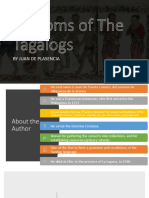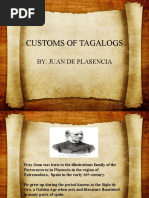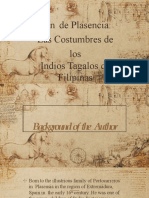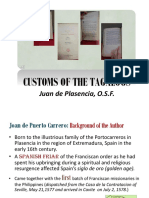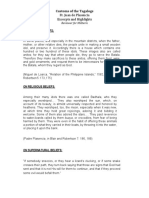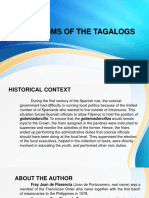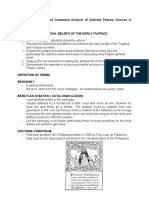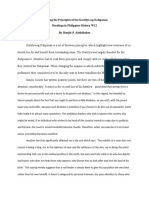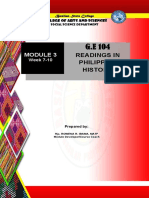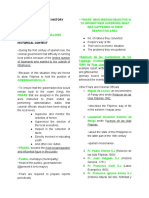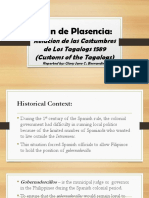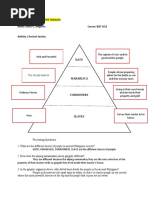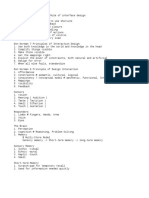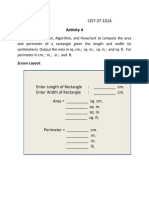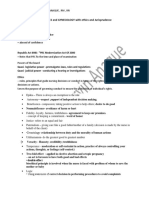100%(2)100% found this document useful (2 votes)
1K viewsFr. Juan de Plasencia and "Native Races and Their Customs" by Francisco Colin
Fr. Juan de Plasencia and "Native Races and Their Customs" by Francisco Colin
Uploaded by
Dale AceboThis document contains a graphic organizer that was filled out by a student comparing the social classes among the Tagalogs and Visayans based on readings from two sources. The graphic organizer lists the social classes from top to bottom for the Tagalogs and their equivalent terms for the Visayans, along with the duties and characteristics associated with each class. The top noble class for both societies were the Maginoo among the Tagalogs and the Datu among the Visayans, who served as leaders and held the most wealth and power. Below this were the warrior classes of the Maharlika and Timaua, and at the bottom were the servant classes of the Alipin Namamahay/Sag
Copyright:
© All Rights Reserved
Available Formats
Download as PDF, TXT or read online from Scribd
Fr. Juan de Plasencia and "Native Races and Their Customs" by Francisco Colin
Fr. Juan de Plasencia and "Native Races and Their Customs" by Francisco Colin
Uploaded by
Dale Acebo100%(2)100% found this document useful (2 votes)
1K views2 pagesThis document contains a graphic organizer that was filled out by a student comparing the social classes among the Tagalogs and Visayans based on readings from two sources. The graphic organizer lists the social classes from top to bottom for the Tagalogs and their equivalent terms for the Visayans, along with the duties and characteristics associated with each class. The top noble class for both societies were the Maginoo among the Tagalogs and the Datu among the Visayans, who served as leaders and held the most wealth and power. Below this were the warrior classes of the Maharlika and Timaua, and at the bottom were the servant classes of the Alipin Namamahay/Sag
Original Title
GALLARDO,SHAINA MAE
Copyright
© © All Rights Reserved
Available Formats
PDF, TXT or read online from Scribd
Share this document
Did you find this document useful?
Is this content inappropriate?
This document contains a graphic organizer that was filled out by a student comparing the social classes among the Tagalogs and Visayans based on readings from two sources. The graphic organizer lists the social classes from top to bottom for the Tagalogs and their equivalent terms for the Visayans, along with the duties and characteristics associated with each class. The top noble class for both societies were the Maginoo among the Tagalogs and the Datu among the Visayans, who served as leaders and held the most wealth and power. Below this were the warrior classes of the Maharlika and Timaua, and at the bottom were the servant classes of the Alipin Namamahay/Sag
Copyright:
© All Rights Reserved
Available Formats
Download as PDF, TXT or read online from Scribd
Download as pdf or txt
100%(2)100% found this document useful (2 votes)
1K views2 pagesFr. Juan de Plasencia and "Native Races and Their Customs" by Francisco Colin
Fr. Juan de Plasencia and "Native Races and Their Customs" by Francisco Colin
Uploaded by
Dale AceboThis document contains a graphic organizer that was filled out by a student comparing the social classes among the Tagalogs and Visayans based on readings from two sources. The graphic organizer lists the social classes from top to bottom for the Tagalogs and their equivalent terms for the Visayans, along with the duties and characteristics associated with each class. The top noble class for both societies were the Maginoo among the Tagalogs and the Datu among the Visayans, who served as leaders and held the most wealth and power. Below this were the warrior classes of the Maharlika and Timaua, and at the bottom were the servant classes of the Alipin Namamahay/Sag
Copyright:
© All Rights Reserved
Available Formats
Download as PDF, TXT or read online from Scribd
Download as pdf or txt
You are on page 1of 2
NAME: GALLARDO, SHAINA MAE DATE: 10/15/2020
COURSE: CEIT-01-104P SCORE: _______
C. GRAPHIC ORGANIZER: Fill the table with necessary details based on the “Customs of the Tagalogs “by
Fr. Juan de Plasencia and “Native Races and their Customs” by Francisco Colin.
SOCIAL CLASSES EQUIVALENT DUTIES CHARACTERISTICS
AMONG TAGALOGS TERMINOLOGY (Tagalog) (Tagalogs)
(From Top to Bottom) AMONG VISAYANS
Maginoo Datu The Datu is the leader The noble class
and is the wealthiest The Maginoo were the
person in the ruling class, the
community called a educated class, the
barangay. He is the royal class, and the
chieftan somewhat privileged class. It was
synonymous to a from this class that the
Monarch, Rajah, Sultan, Datu would come from.
or King. It is unknown if the
#In times of peace: Datu position was
executive, legislator hereditary such as
and chief justice following the lineage of
#In war: he is the the eldest child
commander in chief of especially the eldest
the armed forces. son of the Datu, or if
#foreign affairs: the the Maginoo class (who
datu enables treatise were likely all related to
and truce (sanduguan) one another) elected a
Datu.
Maharlika Timaua They would provide The Maharlika had all
protection to the the rights of the
barangay and were Timawa, but they are
responsible for specifically the warrior
providing and class. They were well
preparing the weapons respected if not revered
at their own expense. by the barangay. They
are also not expected
to pay taxes.
A Maharlika could
change their allegiance
to another barangay by
marrying into it or by
simply moving to it.
This however required
paying a certain
amount to his Datu. A
feast would be given in
his honor when leaving
the barangay.
Namamahay Oripuen Aliping Namamahay The Alipin had the least
was a servant that lived rights. They are not
in their own little house exactly slaves in the
on the property of their traditional sense, but
master. they were indentured
servants. Basically, they
served their master
who belonged to one
of the classes above
them. But it does not
mean that they did all
the work in the
barangay. The Timawa
were probably
expected to do most of
the work in the
barangay, and the
Alipin was likely his or
her servant at home
such as doing house
chores and cooking or
aided the Timawa with
their duties at work.
Sagigilid . Aliping Sagigilid was a An Alipin can actually
Oripuen servant that lived become free and
around the house of become a Timawa
their master provided he or she
fulfilled the services of
their master, this
process is known as
Tinimawa. The Alipin
did not likely make any
money for their
services, and hence did
not pay taxes.
You might also like
- Magellan's Voyage: A Narrative Account of the First CircumnavigationFrom EverandMagellan's Voyage: A Narrative Account of the First CircumnavigationRating: 4 out of 5 stars4/5 (35)
- Butterfly Unit UbdDocument7 pagesButterfly Unit Ubdapi-301187566100% (1)
- Customs of TagalogDocument9 pagesCustoms of Tagalogmaris50% (2)
- ATL Visual MYPDocument5 pagesATL Visual MYPDenice CelisNo ratings yet
- Juan de Plasencia: Customs of The TagalogDocument5 pagesJuan de Plasencia: Customs of The TagalogkimprinceGANo ratings yet
- Reporting - Customs-of-The-TagalogsDocument47 pagesReporting - Customs-of-The-Tagalogsblackfire_sanmelNo ratings yet
- Customs of TagalogsDocument27 pagesCustoms of TagalogsJerre Mae EchalarNo ratings yet
- Customs of The TagalogsDocument11 pagesCustoms of The Tagalogsbuttewcupz100% (5)
- Raiders of The Sulu Sea Documentary SummaryDocument19 pagesRaiders of The Sulu Sea Documentary Summarykimin -100% (1)
- Juan de Plasencia's Customs of The Tagalogs: Readings in Philippine HistoryDocument13 pagesJuan de Plasencia's Customs of The Tagalogs: Readings in Philippine HistoryJethro Marco V. VicenteNo ratings yet
- Primary Source Analysis: Title of Source: Customs of The TagalogDocument2 pagesPrimary Source Analysis: Title of Source: Customs of The TagalogJohn Patrick Camacho0% (1)
- Arguments in Favor of Limasawa, Southern LeyteDocument3 pagesArguments in Favor of Limasawa, Southern LeyteAdrian Jan MoralesNo ratings yet
- Customs of The TagalogsDocument1 pageCustoms of The TagalogsKim Andre Macaraeg75% (36)
- Customs of The TagalogDocument54 pagesCustoms of The TagalogKen Kaneki88% (8)
- Leach CamouflageDocument300 pagesLeach CamouflageStefan KršaninNo ratings yet
- Alternative Treatment For Wildlife PDFDocument46 pagesAlternative Treatment For Wildlife PDFPaula Andrea Rodriguez100% (1)
- Customs of The TagalogsDocument2 pagesCustoms of The TagalogsCarl Dhaniel Garcia Salen67% (3)
- Juan de Plasencia Customs of The TagalogsDocument29 pagesJuan de Plasencia Customs of The TagalogsARLENE PILAR AVECILLANo ratings yet
- Customs of The TagalogsDocument28 pagesCustoms of The TagalogsRitchell B. Aguinido0% (1)
- Name: Jay-R N. Gato Date: March 16, 2021 Course: BPED ScoreDocument3 pagesName: Jay-R N. Gato Date: March 16, 2021 Course: BPED ScoreJay-r Gato67% (3)
- Customs of The Tagalogs Fr. Juan de Plasencia Excerpts and Highlights 1 PDFDocument7 pagesCustoms of The Tagalogs Fr. Juan de Plasencia Excerpts and Highlights 1 PDFanon_202645328100% (1)
- Customs of D Tagalogs ByPlasencia OKKDocument76 pagesCustoms of D Tagalogs ByPlasencia OKKAngelica ArmeaNo ratings yet
- Chiefs - Datu Nobles - Maginoo Freemen - Timawa/Maharlika Slaves - Namamahay/SagigilidDocument2 pagesChiefs - Datu Nobles - Maginoo Freemen - Timawa/Maharlika Slaves - Namamahay/Sagigilid189315100% (3)
- RPH Customs-of-the-TagalogDocument5 pagesRPH Customs-of-the-TagalogMARIA RHODORA BITBITNo ratings yet
- First Voyage Around The World NotesDocument5 pagesFirst Voyage Around The World NotesArchilyn LadesmaNo ratings yet
- Juan de Plasencia (Customs of The Tagalogs)Document4 pagesJuan de Plasencia (Customs of The Tagalogs)Lunar Walker100% (1)
- Historical Critique: Juan de Plasencia, O.S.F., Customs ofDocument36 pagesHistorical Critique: Juan de Plasencia, O.S.F., Customs ofAnonymous GuyNo ratings yet
- Customs of The TagalogsDocument54 pagesCustoms of The Tagalogs11 11No ratings yet
- Answer What Is Being Asked. (100 Points) Instructions: Read The Provisions of The Kartilya NG Katipunan and Through It, Visualize The Dynamics ofDocument2 pagesAnswer What Is Being Asked. (100 Points) Instructions: Read The Provisions of The Kartilya NG Katipunan and Through It, Visualize The Dynamics ofVhon MisakiNo ratings yet
- Chapter 4: Spanish Era: in Search of New LandsDocument3 pagesChapter 4: Spanish Era: in Search of New LandsAliah CyrilNo ratings yet
- Customs of The TagalogDocument29 pagesCustoms of The TagalogJeff Raian Molina BatongbakalNo ratings yet
- Juan de Placencia's WritingsDocument20 pagesJuan de Placencia's WritingsRufo Jawa100% (2)
- Brief Summary of The First Voyage Around TheDocument13 pagesBrief Summary of The First Voyage Around TheSairah B. SanchaNo ratings yet
- WEEK 3 RIPH Juan de Plasencias Customs of The TagalogsDocument10 pagesWEEK 3 RIPH Juan de Plasencias Customs of The TagalogsBeverly A Panganiban100% (1)
- Customs of The TagalogsDocument10 pagesCustoms of The TagalogsDiana Rose83% (6)
- Customs of The TagalogsDocument14 pagesCustoms of The TagalogsDivina Gracia Vibal Cielo67% (3)
- Raiders of The Sulu Sea SummaryDocument2 pagesRaiders of The Sulu Sea SummarySophia Dominique Uy AlzateNo ratings yet
- Custom of The TagalogsDocument15 pagesCustom of The TagalogsMary Joy Morallon Calagui100% (1)
- Pigafetta PlacensiaDocument38 pagesPigafetta PlacensiaIra CruzNo ratings yet
- Customs of The TagalogsDocument51 pagesCustoms of The TagalogsZoe79% (67)
- Kartilya NG Katipunan AnalysisDocument9 pagesKartilya NG Katipunan AnalysisAngelaNo ratings yet
- Customs of The TagalogsDocument4 pagesCustoms of The Tagalogsellamaecenriquez80% (45)
- Module 2 Spiritual Beliefs of Early FilipinosDocument4 pagesModule 2 Spiritual Beliefs of Early FilipinosShelei Blanco IINo ratings yet
- Content and Context Analysis - Customs of TagalogsDocument3 pagesContent and Context Analysis - Customs of TagalogsKyla Jynell Saquiton100% (1)
- Applying The Principles of The Kartilya NG Katipunan - AbdulhalemDocument2 pagesApplying The Principles of The Kartilya NG Katipunan - AbdulhalemHANIFA ABDULHALEM50% (2)
- Readings in Philippine History: Week 7-10Document54 pagesReadings in Philippine History: Week 7-10Carlos Barrios100% (1)
- Ascendance of Chinese MestizosDocument5 pagesAscendance of Chinese MestizosMary Antonette Tagadiad100% (1)
- Reading On Pigafetta's AccountDocument1 pageReading On Pigafetta's AccountTrifon Peligrino100% (1)
- Antonio Pigafetta. First Voyage Around The World, (Pp. 23-48) (Chronicle)Document5 pagesAntonio Pigafetta. First Voyage Around The World, (Pp. 23-48) (Chronicle)Christian ComotNo ratings yet
- Chapter 2 Lesson 1 First Voyage Around The WorldDocument25 pagesChapter 2 Lesson 1 First Voyage Around The WorldNoemi Yumo100% (1)
- Customs of The TagalogsDocument51 pagesCustoms of The TagalogsReymelvin MadridanoNo ratings yet
- Customs of The TagalogsDocument7 pagesCustoms of The TagalogsNidaNo ratings yet
- Life and Works of Emilio D. Jacinto - PPTMDocument36 pagesLife and Works of Emilio D. Jacinto - PPTMJoel BatucanNo ratings yet
- CUSTOMS OF THE TAGALOGsDocument47 pagesCUSTOMS OF THE TAGALOGsGlory Jane BernardinoNo ratings yet
- First Voyage Around The World by Antonio PigafettaDocument26 pagesFirst Voyage Around The World by Antonio PigafettaJayrald RiveroNo ratings yet
- Content and Contextual Analysis - Kartilya NG KatipunanDocument5 pagesContent and Contextual Analysis - Kartilya NG KatipunanJOHN LAWRENCE LOBATON100% (2)
- LESSON 9 Filipino Nationalism and The Cavite MutinyDocument67 pagesLESSON 9 Filipino Nationalism and The Cavite MutinyJohn Lloyd DaroNo ratings yet
- Primary Source Analysis PPT PresentationDocument12 pagesPrimary Source Analysis PPT PresentationKyungstellation KS80% (5)
- Debate First MassDocument11 pagesDebate First MassVanessa Pallar100% (1)
- RPH - Customs of The TagalogsDocument22 pagesRPH - Customs of The TagalogsRegina Carla de Guzman100% (7)
- Customs of The Tagalog (Analysis)Document3 pagesCustoms of The Tagalog (Analysis)Francine SenapiloNo ratings yet
- Fr. Juan de Plasencia and "Native Races and Their Customs" by Francisco ColinDocument2 pagesFr. Juan de Plasencia and "Native Races and Their Customs" by Francisco ColinDale AceboNo ratings yet
- Lesson 2: Customs of The Tagalog Name: Dioco G. Maglinte Course: BSIT AI13Document7 pagesLesson 2: Customs of The Tagalog Name: Dioco G. Maglinte Course: BSIT AI13diocoNo ratings yet
- REPH (Module 3)Document8 pagesREPH (Module 3)KenNo ratings yet
- The Declaration of Martial Law in 1972Document1 pageThe Declaration of Martial Law in 1972Dale AceboNo ratings yet
- Assignment: Acebo, Dale BDocument5 pagesAssignment: Acebo, Dale BDale AceboNo ratings yet
- Nutrition and Eating HabitsDocument24 pagesNutrition and Eating HabitsDale AceboNo ratings yet
- 1973 Constitutional AuthoritarianismDocument1 page1973 Constitutional AuthoritarianismDale AceboNo ratings yet
- Evolution of The Philippines ConstitutionDocument15 pagesEvolution of The Philippines ConstitutionDale AceboNo ratings yet
- Quiz No. 4 Mar. 122021Document4 pagesQuiz No. 4 Mar. 122021Dale AceboNo ratings yet
- Fr. Juan de Plasencia and "Native Races and Their Customs" by Francisco ColinDocument2 pagesFr. Juan de Plasencia and "Native Races and Their Customs" by Francisco ColinDale AceboNo ratings yet
- Laboratory4 Serdan MichaelJohnDocument3 pagesLaboratory4 Serdan MichaelJohnDale AceboNo ratings yet
- (Human Computer Interaction) : Prof. Jaevier A. VillanuevaDocument8 pages(Human Computer Interaction) : Prof. Jaevier A. VillanuevaDale AceboNo ratings yet
- Nutrition and Eating Habits AssignmentDocument4 pagesNutrition and Eating Habits AssignmentDale AceboNo ratings yet
- HCIDocument1 pageHCIDale AceboNo ratings yet
- Fr. Juan de Plasencia and "Native Races and Their Customs" by Francisco ColinDocument2 pagesFr. Juan de Plasencia and "Native Races and Their Customs" by Francisco ColinDale Acebo100% (2)
- Activity 4: Screen LayoutDocument5 pagesActivity 4: Screen LayoutDale AceboNo ratings yet
- Position and Competency Profile: Department of EducationDocument7 pagesPosition and Competency Profile: Department of EducationJordan Tagao ColcolNo ratings yet
- Unit Code: LIT 102 Unit Title: Program(s) : Lecturer Name: Lecturer Contacts: Consultation TimeDocument3 pagesUnit Code: LIT 102 Unit Title: Program(s) : Lecturer Name: Lecturer Contacts: Consultation TimeFelistus NzulaNo ratings yet
- Lecture - wk.3 - TaggedDocument18 pagesLecture - wk.3 - TaggedHarshita SurekaNo ratings yet
- Our International Sports Law Diary The Asser International Sports Law Centre (HTTP://WWW - Sportslaw.nl) Is Part of TheDocument7 pagesOur International Sports Law Diary The Asser International Sports Law Centre (HTTP://WWW - Sportslaw.nl) Is Part of TheAakanksha KumarNo ratings yet
- Nle MCN Road To SuccessDocument59 pagesNle MCN Road To SuccessKaye PatanindagatNo ratings yet
- Best Results Delivered: Moisture MattersDocument14 pagesBest Results Delivered: Moisture MattersCongNo ratings yet
- Eapp - NotesDocument15 pagesEapp - NotesNicole Geraldine Anne DagacanNo ratings yet
- Behavior Theory of Second Language AcquisitionDocument1 pageBehavior Theory of Second Language AcquisitionAhmed100% (1)
- Topic: Grammatical Issues: What Are Parts of Speech?Document122 pagesTopic: Grammatical Issues: What Are Parts of Speech?AK AKASHNo ratings yet
- Spinal Osteotomy 2018Document43 pagesSpinal Osteotomy 2018YoNo ratings yet
- Latest Proposal Seminar in ManagementDocument12 pagesLatest Proposal Seminar in ManagementFifi AqiraNo ratings yet
- Progress in Nuclear Energy: Cláudio M.N.A. Pereira, Celso M.F. Lapa, Antônio C.A. Mol, André F. Da LuzDocument5 pagesProgress in Nuclear Energy: Cláudio M.N.A. Pereira, Celso M.F. Lapa, Antônio C.A. Mol, André F. Da LuzAmaro FreitasNo ratings yet
- ECE131Document2 pagesECE131sohamNo ratings yet
- Eisenhower MatrixDocument12 pagesEisenhower MatrixHOD Auto100% (6)
- Solutions For Automating IT Job Scheduling: Greg ShieldsDocument66 pagesSolutions For Automating IT Job Scheduling: Greg ShieldsjbahnsenNo ratings yet
- Watkins 1992Document53 pagesWatkins 1992Gabriel Mercado InsignaresNo ratings yet
- StatuteDocument14 pagesStatuteYibrailNo ratings yet
- Appellee Vs Vs Appellants The Solicitor General Public Attorney's Office and Ambrosio M. KatlyDocument8 pagesAppellee Vs Vs Appellants The Solicitor General Public Attorney's Office and Ambrosio M. KatlyKathleen MartinNo ratings yet
- Dokumen - Tips Si Cacing Dan Kotoran Kesayangannya 3 Ajahn Resensi Buku Si Cacing Dan KotoranDocument5 pagesDokumen - Tips Si Cacing Dan Kotoran Kesayangannya 3 Ajahn Resensi Buku Si Cacing Dan KotoranNiolita saputraNo ratings yet
- 2024 10 29 07 39 38 127 2022 AttendenceDocument11 pages2024 10 29 07 39 38 127 2022 Attendencefdi.assetsNo ratings yet
- Philosophy of LawDocument116 pagesPhilosophy of LawMaríaFernándezMuñozNo ratings yet
- Muhammad Iqbal and His Major Works (2) - Gana IslamikaDocument6 pagesMuhammad Iqbal and His Major Works (2) - Gana IslamikaNoor ul ainNo ratings yet
- Anderson v. Ho, G.R. No. 172590, January 7, 2013Document2 pagesAnderson v. Ho, G.R. No. 172590, January 7, 2013Jayson Gabriel Soriano100% (1)
- IndigoDocument10 pagesIndigoAshwin AgarwalNo ratings yet
- Pi Key Audit MattersDocument24 pagesPi Key Audit MattersMohammedYousifSalihNo ratings yet
- M CAPS 01 Botany (PMTcorner - In)Document4 pagesM CAPS 01 Botany (PMTcorner - In)BiniNo ratings yet





